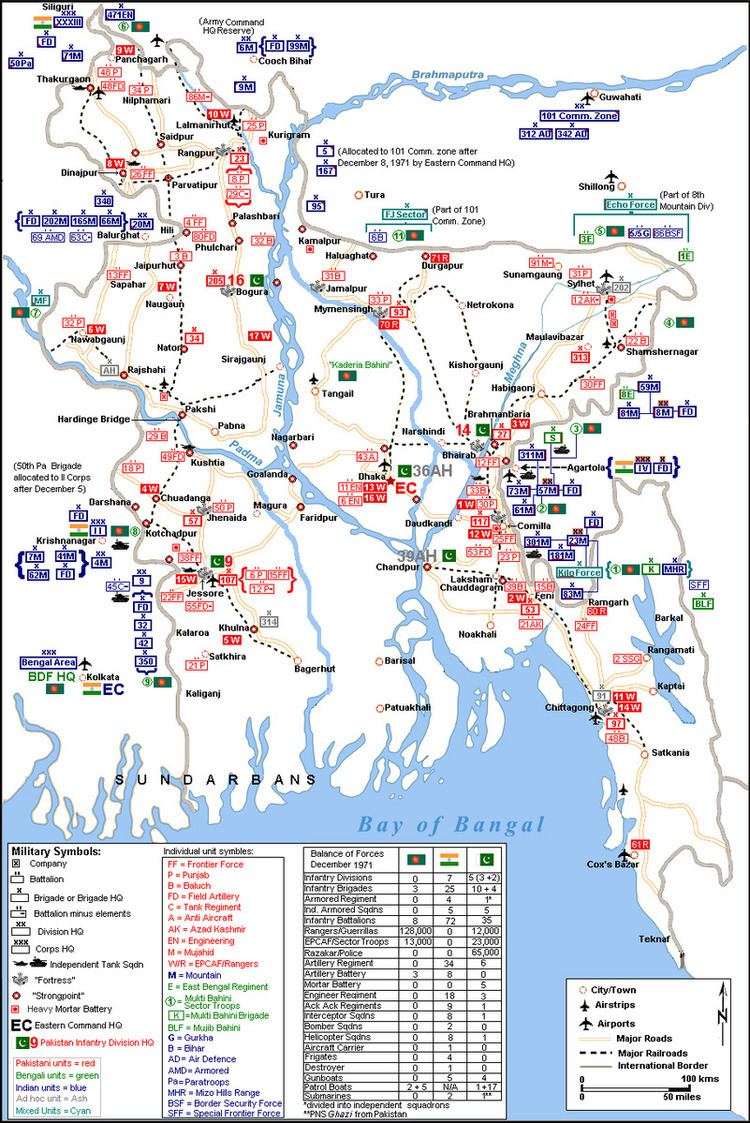 | ||
The Indian Army had no standby force ready in 1971 with the specific task of attacking West Pakistan, one of the many reasons why India did not immediately intervene after Pakistan launched Operation Searchlight in March 1971. Indian Army Eastern Command was tasked with defending the northern and eastern borders and fighting the insurgencies in Nagaland, Mizoram and Naxalites in West Bengal at that time. Mukti Bahini, aided by the Indian army through Operation Jackpot, led the struggle against the Pakistan army while the Indian army readied for intervention. General M. A. G. Osmani, Commander in Chief Bangladesh Forces, had divided Mukti Bahini forces into 11 geographical sectors for command and control purpose. Mukti Bahini forces numbered 30,000 regular soldiers (including 3 brigades containing 8 infantry battalions and 3 artillery batteries) and at least 100,000 guerrillas by December 1971. The Indian Army Eastern Command assembled two existing infantry corps, the IVth and the XXXIIIrd, for operations in Bangladesh, and created a new corps (II) besides reorganising the 101st Communication Zone as a combat formation. On 21 November 1971, Indian and Bangladesh forces were put under a joint command structure, led by Lt. Gen. Jagjit Singh Aurora, and this force came to be known as Mitro Bahini. In addition to 29 BSF battalions, Mukti Bahini guerrillas operating near the border or awaiting deployment in camps inside India were organised into infantry companies and attached to various Indian formations.
Contents
- Indian Army Eastern Command HQ Fort William Kolkata
- Corps Bengal Area
- Western Sector
- Corps II
- 9th Infantry Division
- 4th Mountain Division
- North Western Sector
- Corps XXXIII
- 20th Mountain Division
- 6th Mountain Division
- North Eastern Sector
- 101st Communication Zone
- Eastern Sector
- IV Corps
- 8th Mountain Division
- 57th Mountain Division
- 23rd Mountain Division
- Indian Navy Eastern Fleet
- Bangladesh Navy
- Indian Air Force Eastern Command
- References
Indian Army Eastern Command HQ: Fort William, Kolkata
GOC-in-C (Indian Army): Lt. General Jagjit Singh Aurora
COS: Maj. Gen. JFR Jacob
Director Military Operations: Major General Inderjit Singh Gill, MC
Director Operation Jackpot: Lt. Gen. B.N. 'Jimmy' Sirkar
Bangladesh Forces Liaison: Group Captain A.K. Khandkar,
HQ: 8, Theater Road, Kolkata
Units attached to Eastern Command but outside Bangladesh operational area:
From IV corps:
From XXXIII corps:
Airborne forces attached to Eastern Command:
Eastern Command Reserve:
Corps: Bengal Area
GOC: Maj. Gen. J.P. Chowdhury HQ: Kolkata
Western Sector
Area of Operation: Khulna, Jessore, Kushtia and Faridpur districts
Corps: II
GOC: Lt. Gen T.N. 'Tappy' Raina, HQ: Krishnanagar, West Bengal
9th Infantry Division
GOC Maj. Gen. Dalbir Singh
4th Mountain Division
GOC: Maj. Gen. M.S. Barar HQ: Krishnanagar
North Western Sector
Area of Operation: Rajshahi, Bogra, Dinajpur and Rangpur districts
Corps: XXXIII
GOC: Lt. Gen. M. L. Thapan HQ: Siliguri, West Bengal
20th Mountain Division
GOC: Maj. Gen. Lachman Singh HQ: Balurghat, West Bengal
6th Mountain Division
(Eastern Command HQ Reserve) GOC Maj. Gen. P. C. Reddy HQ: Kooch Bihar, West Bengal
North Eastern Sector
Area of Operation: Mymensingh and Tangail districts
101st Communication Zone
GOC: Maj. Gen. Gurbax Singh Gil HQ: Guwahati, Assam
Eastern Sector
Area of Operation: Sylhet, Comilla, Noakhali & Chittagong districts
IV Corps
GOC Lt. General Sagat Singh HQ: Agartala, Tripura
8th Mountain Division
GOC: Maj. Gen. K.V. Krishna Rao
57th Mountain Division
GOC: Maj. Gen. B.F. Gonsalves
23rd Mountain Division
GOC: Maj. Gen. R.D. Hira
Indian Navy Eastern Fleet
FOC: Vice Admiral N. Krishnnan HQ: Vishakhapatnam, Andhra Pradesh
Fleet Commander: Rear Admiral S. A. Sharma
A liaison officer from the Navy was posted at Fort William to coordinate matters with the Army Eastern Command. The fleet was at its peacetime standing when radio intercepts warned of PNS Ghazi entering the Bay of Bengal. INS Vikrant and part of the fleet was moved to the Andamans as a result.
Bangladesh Navy
Two gunboats under Indian officers and crewed by Bengali seamen were engaged in Operation Hotpants prior to 3 December 1971, harassing merchant traffic to East Pakistan and laying mines on the waterways. After 6 December, when the Indian government recognised Bangladesh as a sovereign nation, the crew wore uniforms of their respective organisations.
Squadron CO: Commander N.M Samant (On deputation from Indian Navy)
Indian Air Force Eastern Command
AOC: Air Marshal H. C. Dewan, Temporary advanced HQ at Fort William
Prior to 1971, Indian Air Force had two command centers dealing with the East, Eastern Command (HQ Shillong) responsible for the North Eastern Border, and the Central (HQ Allahbad), looking after areas south of the Ganges river. Air Chief Marshal P.C Lal formed an advance HQ at Fort William after consultation with Maj. Gen Jacob to coordinate operations with the army before the start of the war.
Western Sector:
North East and North Western Sector: AOC-in-C: Air Vice Marshal Devasher HQ: Shillong
Bangladesh Air Force: Kilo Flight CO: Flight Lt. Sultan Mahmud HQ: Dimapur Nagaland, then Agartala
This unit was formed by Bengali pilots and technicians defecting from the Pakistan Air Force. Flying light aircraft donated by India, they launched attacks on depots and communication lines on 2 December 1971, before the start of the war. The unit relocated to Agartala and then Shamshernagar after 3 December 1971.
